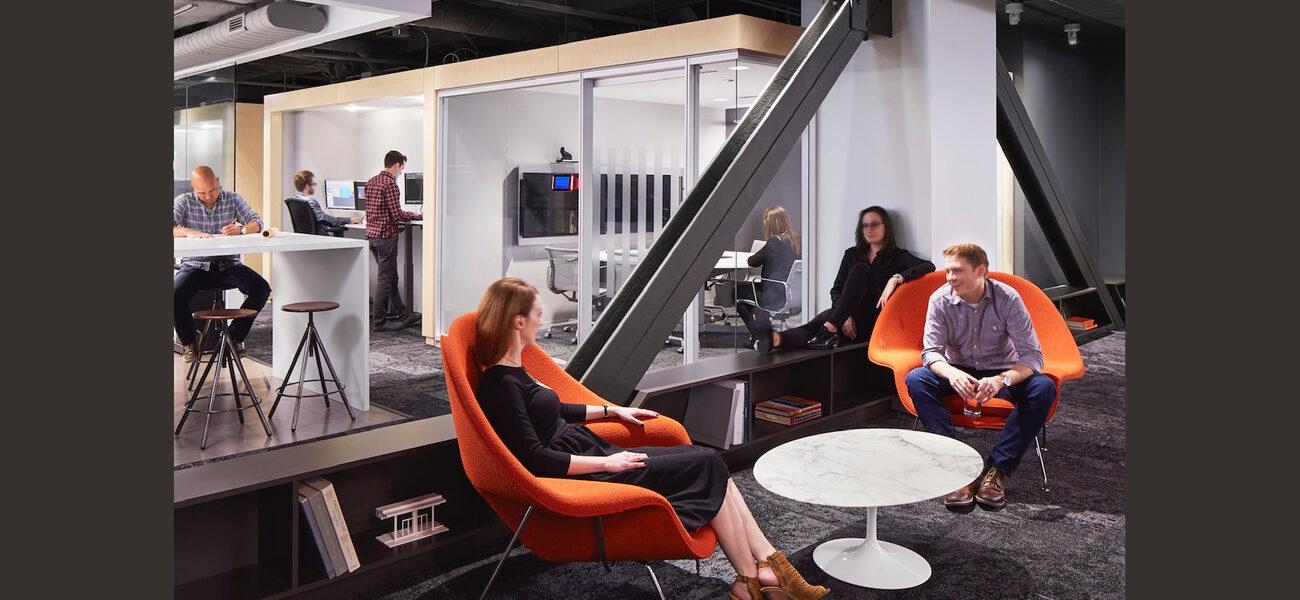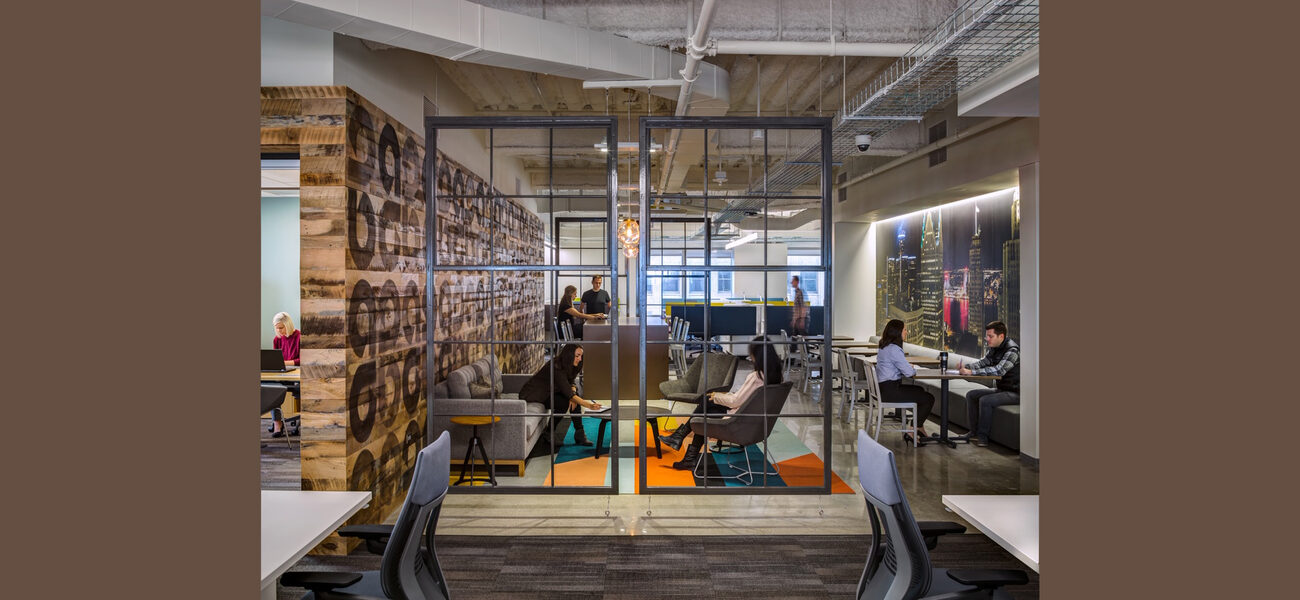Asking a company to define its culture often results in an ambiguous response, but answering that question is key to addressing business concerns with the most effective workplace and organizational design solutions. Organizational strategies reflect the structure of the business, can identify workflow and system inadequacies, and should support workplace design. Assessing a company’s business objectives, functional needs, space utilization, necessary workplace improvements, user requirements, and operating capabilities can be instrumental in making the best design decisions. This approach is built on a foundation of viewing design as an enterprise-level service capable of solving business problems, and not just real estate issues.
It is difficult to solve problems until companies understand the connection between their business and their culture, so the architectural and engineering firm of SmithGroup begins its planning sessions with clients by asking them to define their culture and specify their business objectives. Then they can address the right problem in an appropriate manner to help the company achieve its goals and support its culture.
“We develop design solutions that reflect the culture and enable that culture to be successful,” says Stephanie Mitrovic, science and technology studio leader at SmithGroup. “First, we identify the culture and what that culture means for the organization. The next steps are to identify a design strategy that reflects that culture in terms of the assignment of work settings and to incorporate planning principles and typologies that support the culture.”
Cultural Components
Companies are comprised of five components: business strategy, organizational structure, work processes, people, and rewards system. The rewards system to motivate employees can be a monetary incentive, such as a paycheck; pride in the values or mission of the company; or a belief by the employee that he or she deserves a certain type of workspace based on his or her title.
“Culture is about the sum total of these five elements,” says Arnold Levin, formerly a workplace strategist principal at SmithGroup. “We talk about culture being collaborative. Culture is not this amorphous, never-never land thing that you sprinkle pixie dust around and then all of a sudden you become collaborative. If you have a collaborative culture, it is because your business strategy needs that type of culture, your work processes support collaboration, you have a rewards system that supports collaboration, your people support collaboration, and this environment supports your business strategy.”
Culture stems from the ways a company brings together its business strategy, organizational structure, management styles, work processes, and people, and how it rewards its staff both monetarily and through workplace organization. The business strategy sets the tone of the company’s current culture and the culture necessary to execute the strategy, while the organizational structure refers to the management style, such as a hierarchy or a bureaucracy.
“If one says they are a collaborative culture and they are managed as a bureaucracy, it is antithetical to a collaborative organization,” says Levin.
The way a company utilizes and deploys its work processes via technology, collaboration, focus work, social interaction, and training reflects the culture of the enterprise. Maintaining a certain workplace culture requires the staff to support and engage with that type of cultural environment.
“If transparency and working cross-enterprise is a company’s culture, it needs a system that rewards staff for being transparent and working across business lines,” says Alexis Kim, director of workplace strategy at SmithGroup. “If you are being reviewed for your individual work contribution as opposed to your contribution to the organization, it creates an operational environment where employees view their own work as more important than the work of the enterprise. If you want to break down barriers across business lines, accounting protocols need to reflect that type of work and not be based on the sole success of individual departments or business units. The reward systems can either support or inhibit the success of the desired culture.”
Developing Design Strategies and Managing Change
Conducting a comprehensive analysis of a client’s organizational structure, its culture, needs, and objectives is necessary to develop the proper design strategy and organizational solutions to meet the company’s short- and long-term goals.
Understanding culture through the lens of organizational design helps determine what changes will occur, how the transformation will be managed, and what must be done to solve the client’s actual problem well. For example, one client thought it could solve its problems with construction of a new headquarters, but it was later determined that the real problem was a need to eliminate silos between departments.
The necessary design features vary from client to client, depending on each client’s culture.
“If collaboration is a core component of the culture, then providing a range of collaborative spaces is essential,” notes Mitrovic. “If research and focus work are part of that culture, offering a variety of spaces for individual, contemplative, and research work is essential.”
Examples of organizational issues that can inhibit collaboration are using meetings for managing the process rather than solving problems; and not making collaboration integral to the overall way business is conducted.
“The right design cannot solve this problem,” says Mitrovic. “Workplace design can provide the right spaces to support collaboration, but the organization needs its organizational design to be one where collaborative processes and culture are core components.”
Embracing the best design solutions starts with gathering data about all aspects of the company and its objectives, and surveying employees to determine their needs and their daily work activities. Properly interpreting all of the information will make it easier to connect the culture, the business objectives, and the overarching workplace and organizational design solutions.
Once all of the fundamental questions are answered, and a design strategy is developed, it is important to facilitate change management by obtaining buy-in from key stakeholders starting with the senior leadership.
“Our most successful projects have been those where there has been interaction with the senior leadership that helped drive the message by connecting with facilities, human resources, and information technology,” says Levin. “It’s important to communicate the reasons for the changes and to make a business case for how the changes benefit the individual employees and the business enterprise.”
SmithGroup worked with a global mining client to design a new headquarters, develop its workplace strategy, and provide change management services. As part of the change management program, workshops were held to discuss the changes; educate employees about their responsibilities; and train managers, human resources personnel, and staff. Upfront communication is imperative for creating a design strategy to support a culture that moves a client toward its mission and business objectives.
Case Studies Exemplify New Metrics
Creating design strategies indicative of a client’s culture means focusing on more than quantitative, cost-driven metrics, such as square feet per person, cost per square foot, kilowatts per square foot, net to gross, and initial costs. SmithGroup leaders are seeing a trend shift, where emphasis also is placed on qualitative values, including recruitment, retention, engagement, wellness, and productivity.
“While the traditional metrics in real estate, such as square feet per person, remain relevant, the majority of an organization’s investment is on people,” says Kim. “Why would we focus only on the real estate footprint when we should look at the opportunity for physical space to contribute better toward wellness, productivity, and engagement of the people? While it may be hard to measure qualitative values of design, it is imperative these aspects be considered as much as quantitative values.”
Three of SmithGroup’s projects—Lake Trust Credit Union in Brighton, Mich.; Ally Financial in Detroit, Mich.; and SmithGroup’s own Chicago office—demonstrate how design elements can reflect a client’s culture and incorporate the new metrics. After the projects were completed, employee satisfaction surveys showed enhanced productivity, interaction, and recruitment.
Lake Trust Credit Union
SmithGroup worked with Lake Trust leaders and employees to design a new high-performance headquarters with a collaborative environment, featuring an open staircase and a variety of spaces to facilitate interaction. The design team combined elements of the building’s wooded site with spaces that encourage collaboration and maximize views to the outside. Features include accordion doors and cantilevered balconies, which blur the boundaries between interior and exterior workspaces.
Interactive design workshops engaged Lake Trust stakeholders and allowed employees to define their new work environment, facilitating buy-in, reflecting the company’s democratic and inclusive culture, and giving team members a sense of pride.
“As work and life boundaries further erode, the workplace needs to provide thoughtful design strategies that include amenities, choice, and variety for team members to support individual work styles, work modes, and lifestyle,” says Mitrovic. “There’s not one solution that is right for all, so it requires investigation into what is right for each organization.”
Team member surveys show that 85 percent believe the new workplace supports ad hoc interaction and makes them feel more productive, while 88 percent report the new space facilitates visual connection to colleagues and improves decision-making, and 90 percent say it improves their health and wellbeing.
Ally Financial
Ally Financial’s new corporate headquarters in Detroit includes 13 floors, each of which has furniture, fixtures, and art to depict the style of a certain area of the city. For example, SmithGroup designed the ninth floor to pay homage to the high-rise buildings in the downtown area by using wall-to-ceiling engravings and aluminum extensions to partition and decorate the office interior. The creative design is intended to spark collaboration and innovation in its new, mostly open floor plan. The design coincides with Ally’s talent base, role as a technological innovator, and its connection to culture and the community.
Surveys show that 91 percent of employees believe the new workplace reflects the culture, brand, and values of the organization; 89 percent are inspired to do their best work; 73 percent believe the workplace positively affects recruiting; 73 percent find the new technology supports collaboration; 97 percent believe the building enhances innovation; and 86 percent believe it fosters collaboration.
SmithGroup Chicago Office
The company reinvented its workplace design strategy into a 21,000-sf workspace on the ninth floor of the historic Jeweler’s Building. The open studio design supports the company’s market expansion strategy with built-in flexibility for growth and helps attract and retain top talent with a vibrant work environment. The office provides a variety of enclosed rooms and desk solutions to accommodate the changing needs of staff.
Active project areas enable impromptu collaboration, and quiet zones facilitate focused work. The spacious lobby provides additional areas for breakout sessions or group collaboration, while a dramatic ceiling adds a spark of excitement and creativity.
According to post-occupancy surveys, 93 percent of employees believe the new workplace supports collaboration, marking a 74 percent increase from the previous space. At least 90 percent believe the environment supports the company’s culture and provides the necessary spaces for focused work.
“We transformed the entire enterprise into a totally agile work environment where we took away dedicated workspaces,” says Levin. “A lot of the change is based on a transformation of the culture, where we want to break down silos and create an organizational design that supports the business enterprise.”
An agile business model incorporates change through reorganization of the business units and processes, allowing the organization to effectively respond to unplanned disruptions within its business environment.
“The role of change becomes imperative in terms of how we look at evolving cultures,” says Levin.
By Tracy Carbasho
| Organization | Project Role |
|---|---|
|
Architect
|



